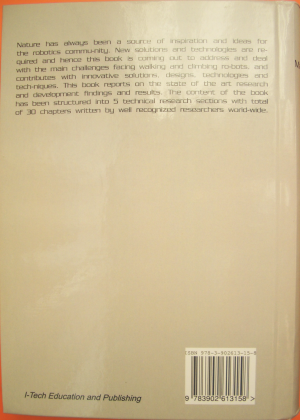|
P16:
”Locomotion Principles of 1D Topology Pitch and
Pitch-Yaw-Connecting Modular Robots”
|
|

|

|
Book:
“Bioinspiration and Robotics: Walking and Climbing Robots”
Edited
by Maki K. Habib, from Saga University, Japan
Publised
by Advanced Robotic Systems International and I-Tech
Education and Publishing. Vienna. Austria.
ISBN:
978-3-902613-15-8
Contents
size: 30 Chapters, 544 pages
Chapter
24: “Locomotion Principles of 1D Topology Pitch and
Pitch-Yaw Connecting Modular Robot”. pp.403-428
|
J.
Gonzalez-Gomez,
Houxiang
Zhang and Eduardo
Boemo, Locomotion Principles of 1D Topology Pitch and
Pitch-Yaw-Connecting Modular Robots. Chapter 24 of the Book:
Bioinspiration and Robotics: Walking and Climbing Robots.
pp.403-428. Published by Advanced Robotics Systems International and
I-Tech Education and Publishing. Vienna, Austria. September 2007.
ISBN 978-3-902613-15-8.
Short Description
The
last few years have witnessed an increasing interest in modular
reconfigurable robotics technologies. The applications include
industrial inspection, urban search and rescue, space applications
and military reconnaissance. They are also very interesting for
research purposes. New configurations can be built very fast and
easily, for the exploration, testing and analysis of new ideas.
Modular
robots can be classified according to both the connection between the
modules and the topology of its structure. One important group is the
Snake robots. It includes the configurations consisting of one chain
of modules (1D Topology). The locomotion is performed by means of
body motions. Depending on the type of connection between the
modules, there are pitch, yaw and pitch-yaw connecting snakes robots.
Many researchers have studied the locomotion capabilities of the yaw
family. There are also research works about different kind of gaits
for specific pitch-yaw modular robots. However, the locomotion
principles for the whole family are not well understood.
In
this chapter we propose a model for the locomotion of the pitch-yaw
snake robots that allow them to perform five different gaits: forward
and backward, side-winding, rotating, rolling and turning. Each joint
is controlled by means of a sinusoidal oscillator with four
parameters: amplitude, frequency, phase and offset. The values of
these parameters and the relations between them (locomotion
principles) determine the type of gait performed and its trajectory
and velocity.
Another
issue is the minimal configurations that can move both in 1D and in
2D. Experiments show that configurations consisting on two and three
modules can move in 1D and 2D respectively. The locomotion principles
of these two minimal configurations are studied and then applied to
modular robots with n modules.
Experiments
on real modular robots have been carried out. Four prototypes have
been built: The two minimal configurations and two eight-modules
snakes, with both pitch and pitch-yaw connections. The successful
experiments confirm the locomotion principles. In addition, it has
been shown that this model can be applied for implementing locomotion
capabilities on real snake robots.
Download
IEA
ROBOTICS
Juan González
[Index
of papers]

